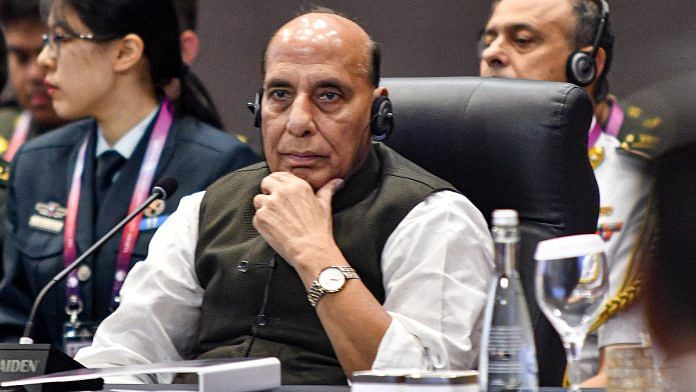New Delhi: After calling out China’s aggression in the South China Sea at the India-US 2+2 meeting in New Delhi last week, Defence Minister Rajnath Singh reaffirmed Thursday that India was committed to “freedom of navigation and unimpeded commerce in international waters”.
Singh, who was speaking at the 10th ASEAN Defence Ministers’ Meeting-Plus (ADMM-Plus) in the Indonesian capital of Jakarta Thursday, also appreciated the grouping’s role in “promoting dialogue and consensus in the region”.
Last week, during the 2+2 ministerial dialogue with America, Singh had stressed on the need to counter China’s aggression in the Indo-Pacific region.
On Thursday, Singh called for security initiatives — such as the ASEAN — to be “consultative and development-oriented”, adding: “We (India) are committed towards nurturing practical, forward-looking and result-oriented cooperation with ADMM-Plus for enhancing maritime security in the ASEAN region.”
The Association of Southeast Asian Nations or ASEAN is an intergovernmental organisation comprising Brunei, Cambodia, Indonesia, Laos, Malaysia, Myanmar, the Philippines, Singapore, Thailand, and Vietnam. India is part of the ASEAN Plus Six grouping, which also includes China, Japan, South Korea, New Zealand and Australia.
The ADMM is the highest defence consultative and cooperative mechanism in ASEAN. Since 2017, this grouping has met annually to strengthen cooperation among ASEAN and the Plus countries. Indonesia is hosting the meeting this year as the current chair of ADMM-Plus.
‘Not an era of war’
In his address to other defence ministers, Singh emphasised on the importance of dialogue and diplomacy to have “enduring peace, and in ensuring global stability”. He also reiterated India’s global message – “this is not an era of war” – and spoke about the imperative to give up the “us versus them” mindset.
The South China Sea is an essential shipping route and one of the busiest waterways in the world. According to the United Nations Conference on Trade and Development, roughly $3.37 trillion or 21 percent of global trade travelled through these waters in 2016.
Incidentally, China claims “indisputable sovereignty” over 90 percent of the South China Sea on the basis of a U-shaped “nine-dash line”, etched on a map in the 1940s by a Chinese geographer.
Earlier this year, ASEAN foreign ministers had appealed to countries to “exercise self-restraint” in their practices along the South China Sea. The joint statement highlighted land reclamations, in what was seen as a subtle warning to China about its activities in the region.
Apart from interacting with ASEAN member countries, Singh also met US Defence Secretary Llyod Austin on the sidelines of the Jakarta meeting. The two ministers discussed ways to contribute to ASEAN’s centrality in the Indo-Pacific in accordance with this year’s theme “Peace, Prosperity and Security”.
They also discussed bilateral issues including expanding the India-US partnership to address rising global challenges and advance defence technology cooperation between the two countries.
(Edited by Tikli Basu)
Also read: Behind the scramble for ASEAN: China to US, top economies court Southeast Asia at Jakarta summits



